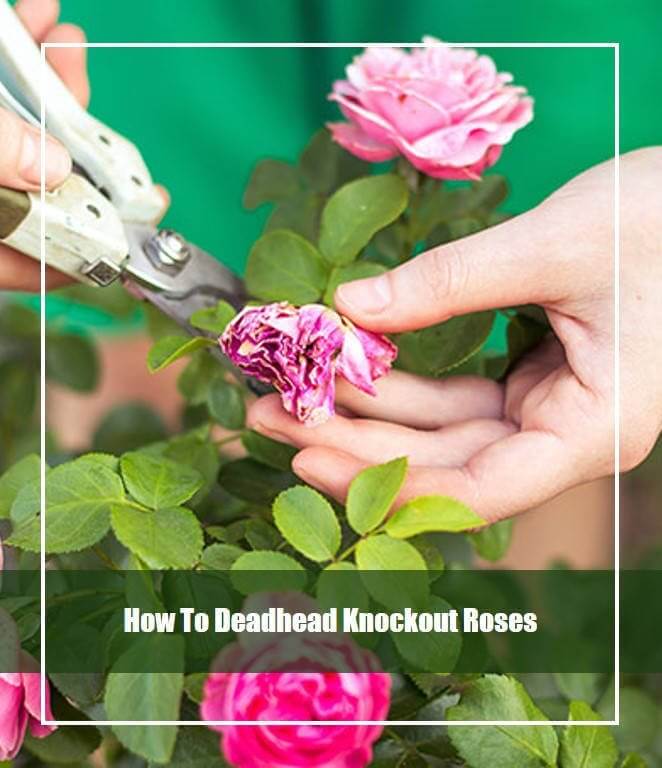Removing dead flowers head from the plants to encourage further blooms is called deadhead and to do that hold the spent knockout blooms and twist by hand. Sounds simple, right?
But remember; this is the traditional method of deadheading called the twist and snap method which can’t fulfill all the purpose of the deadheading of knockout roses.
Sad but true! If you don’t deadhead your knockout roses correctly, it may develop a blind stem that won’t produce any blooms.
That’s why here I will discuss the best way to deadhead knockout roses step by step and hope it will help you to encourage your knockout rose to rebloom.
So, without further ado, let’s get started-
6 Steps of Deadheading the Knockout Roses
Items Required for Deadheading:
- Pruning Shear (our pick: Fiskars Steel Bypass Pruning Shears)
- Pruning Gloves (our pick: HANDLANDY Rose Pruning Gloves)
- Wound Pruning Sealer (our pick: Tanglefoot Tree Wound Pruning Sealer)
Step 1: Sterilize the Shear
For deadheading, you need a sharp, rustless, sterilized pruning shear. Remember, rusty and blunt shear can damage the plant and spread diseases.
To sterilize the pruning shear-
Mix 100 ml liquid bleach into 900 ml water(1:9 ratio) and soak the tool for 20-30 minutes.
Step 2:Determine the Roses Need to Be Removed
It is the most important step of deadheading the knockout roses. If you don’t determine the roses need to be trimmed, you will see the spent blooms again the next day morning. So, here is the checklist that will help you to understand which flowers you should remove-
- Fully spent or dead flowers.
- Flowers with a few petals.
- Flowers about to die in a day (Shake gently to understand).
Step 3: Determine Where to Cut
You should be tricky to determine the place of the cut. Observe the stem of the spent blooms. If you notice any new growth or developing branch on the stem. Just cut 1 inch above the new growth.
Where to deadhead roses if you don’t see any new growth on the stem of spent blooms? Don’t worry. Now you should apply the 5-leaf junction method to deadhead your knockout roses.
Go down and count the leaves of the Leaflet. Stop at the point where you get the first leaf set with five leaves. Place the pruning shear 1 inch above the 5 leaflet leaf set and cut.
Why 5 leaflet leaf sets?
Because 5 leaflet leaf set is the thicker place of the stems that can support the new healthy growth and also that place has a tendency to new growth.
In contrast, if you cut above the 2 or 3 leaflet leaf sets, then you get a new branch that may not bloom. This type of stem is called the blind stem.
Step 4: Type of The Cut
Round or angle cut: which type of cut is perfect for deadhead of knockout roses. Some gardeners claim angle cut is helpful to shed off the water easily. It may true But there is no harm to the round cut.
Step 5: Seal the Cuts
This is an optional step that may follow. It is not necessary. The plant has the capacity to heal the cuts itself. Thereafter, you can seal the cuts with the wound pruning sealer.
When to Deadhead Knockout Roses?
Spent blooms don’t look beautiful and even they ruin the beauty of healthy blooms. So, you should start deadheading when you see some spent blooms in your plant bush.
The general schedule of deadheading is once per week during the summer season until the first frost comes.
Benefits of Deadheading
Deadheading is the most popular cultural term for flower gardeners today. Obviously, the gardeners have not been deadheading without any benefits. Let’s see what are the main benefits of deadheading to knockout roses-
Beautification
No one likes to see the spent or dead blooms and buds along with beautiful, vibrant rose blooms. That’s why gardeners deadhead to keep neat and increase the beauty of the knockout rose bush.
Promote Flowering
If you deadhead the spent flowers before producing seed, then channel the energy of the roses into a direction that promotes new healthy growth and blooms. Also, the conserve energy helps to improve the overall plant health.
Deadheading Vs. Pruning
There is not too much difference between deadheading pruning. That’s why many people get confused with those gardening terms.
Pruning
Pruning is the gardening practice that involves removing the overgrown branches and stems, dead parts of plants, buds, and roots. The objectives of pruning are; shape the plants, increase the airflow, protect the plant from diseases, remove dead or damaged parts of the plant, and promote new growth.
Deadheading
Deadheading is the type of pruning where only the spent blooms are removed to promote the new growth that produces healthy and long-lasting blooms. It is done only in the growing season before the frost comes.
Conclusion
Deadheading is the most important practice for knockout roses that helps the plant to promote new growth and blooms like a knockout rose fertilizer.
So, deadhead correctly and produce lots of new blooms without developing blind stems and I hope now you know how to deadhead knockout roses correctly. So, what are you waiting for? Take your pruners and remove the dead blooms.

